
Whether you are working with a client or on your own product, forecasting is an important first step in SEO work. Not only will it provide an idea of the direction, it can create the necessary accountability for later measurement. While forecasting may not provide 100% accuracy, it can provide a glimpse of what to expect from SEO efforts. And at times, the forecast results can save many future headaches.
A simple glance at the outcomes you anticipate can quickly identify whether you are about to invest an exorbitant amount of time and money into a project that physically cannot yield the results you want.
For example, if your website is built in a way that already limits your SEO effectiveness, like a single-page application design which you have no intention of changing, it’s entirely possible that you will not drive enough additional inbound traffic to justify the effort you put into optimizing your site.
Your forecast can give you clues into what your net return on investment might be. If you anticipate that you will drive 10,000 additional organic users to your site each month, that can be a great starting point.
Assigning value to forecasted SEO performance will indicate how much achieving those goals is worth. Comparing that value to the amount needed to be spent in order to drive the projected results will indicate whether the investment is profitable or not.
Without overpromising on what SEO can deliver, it is a good idea to shoot for a truly great ROI rather than a net positive. However, as forecasting can never be truly precise due to unforeseen variables (e.g. your costs might increase, or the Google SERPs can change causing you to drive lower traffic), you should aim to create a strategy that results in a big enough ROI to ensure you’re not left in the red should those circumstances occur.

Depending on the type of business you have, your projections should reflect the biggest areas of impact. It makes little sense to do full-year projections on seasonal items that sell only during one month of the year.
Conversely, calculating projections for a quarter for products that drive revenue all year is the wrong path to take.
It’s important to remember that SEO is a unique marketing channel that can continuously drive results even after you’ve completed the difficult technical work and are simply maintaining the site. For example, while revenue driven through direct ads will cease as soon as your ad campaign ends, SEO work can continue driving results long after you’ve finished optimizing your site. It’s thus important to give your SEO campaign ample time to prove ROI as revenue will not rise in tune with spending at the start.
Method 1: Annual projections
If you are a year-round business and anticipate that SEO will impact the bottom line throughout the year, then you should calculate your projections based on a full calendar year. The way to do this is look at the areas where you expect to see impact and give a conservative estimate of projected results.

Here are the steps to forecasting annual SEO ROI. We’ll use a sports site as an example to illustrate the process.
1. Compile the data on the historical performance of unbranded keywords for your site in Organic Search by exporting from Google Search Console. For maximum accuracy we recommend pulling data via the Google Search Console API. For illustrative purposes we will be using the 1000 results from the export in the user interface.
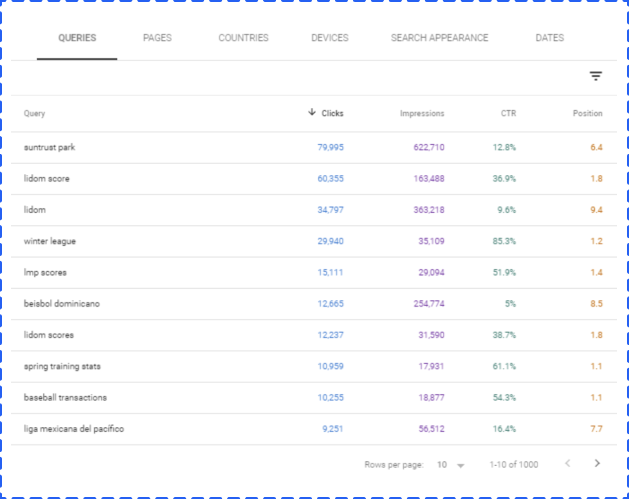
The exported data will look like this in Excel:
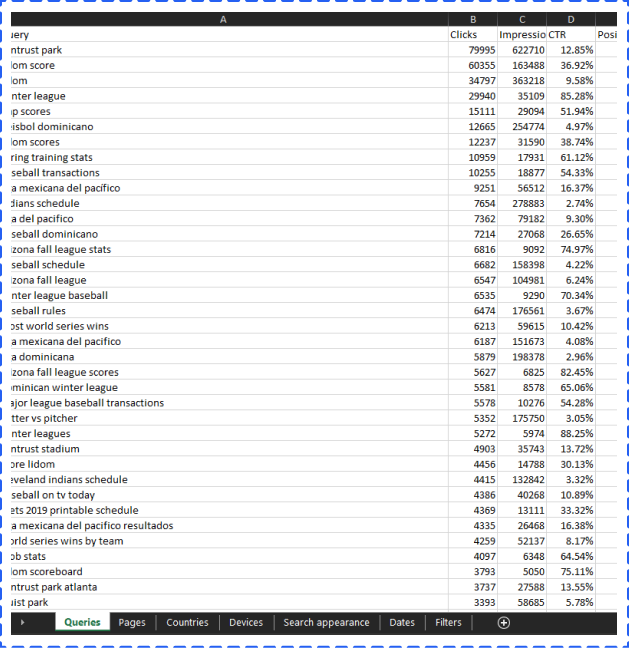
2. Google Search Console gives an average position value, we want to calculate a CTR curve, so we need to round up to a Rankings value. Do so by creating column F and performing the =ROUND(E2,0) function
and fill down.
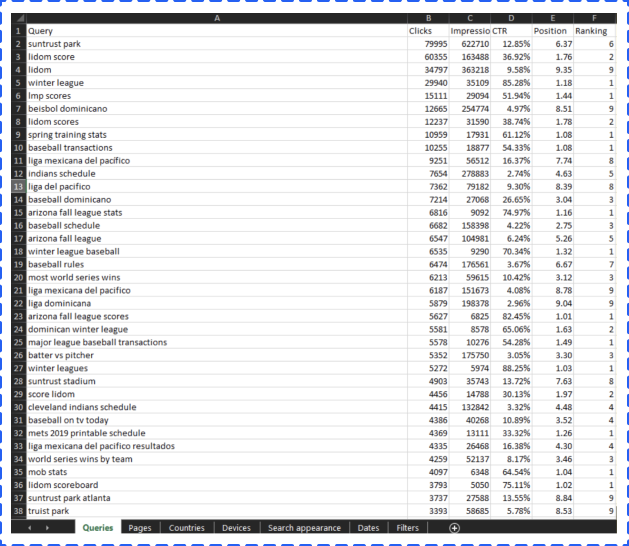
3. Create a pivot table of Ranking vs the Average of CTR.

4. Using Rankings 1-10 create your CTR Curve. For extra insight, you can consider pulling live data from AWR’s CTR Study to compare your performance against others in your vertical.
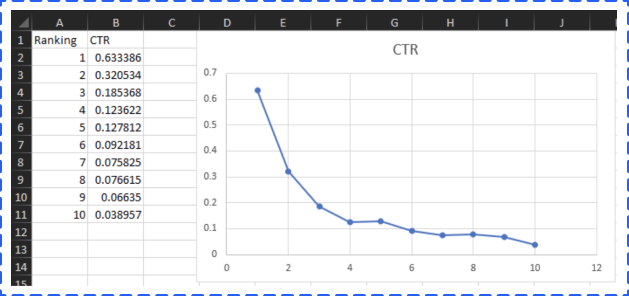
5. Identify the annual search volume of keywords that you do not rank in the top 10 for. You can do this using third party keyword research tools. Also, collect the Organic Search conversion rate, and, if applicable, the average order value. Multiple the CTR by the Conversion Rate to get the amount of potential traffic.
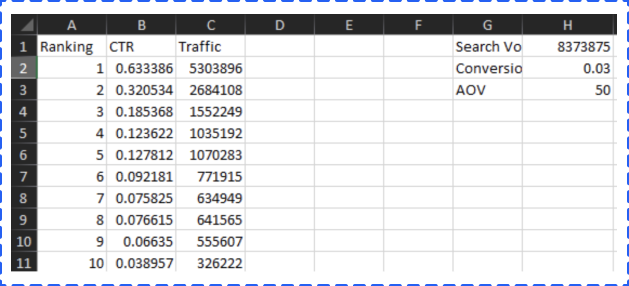
6. Multiply the traffic value by the Organic Search conversion rate to compute the number of potential conversions.
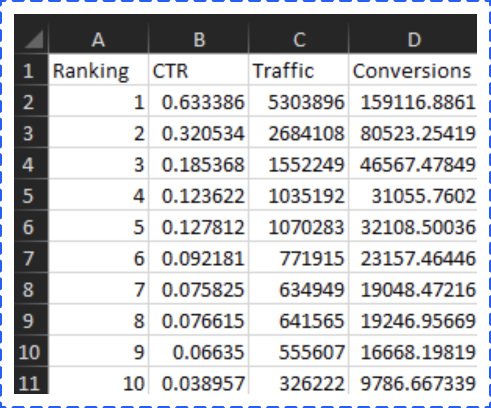
7. Multiply the conversion value by the average order value to determine the potential incremental revenue that this effort will yield.
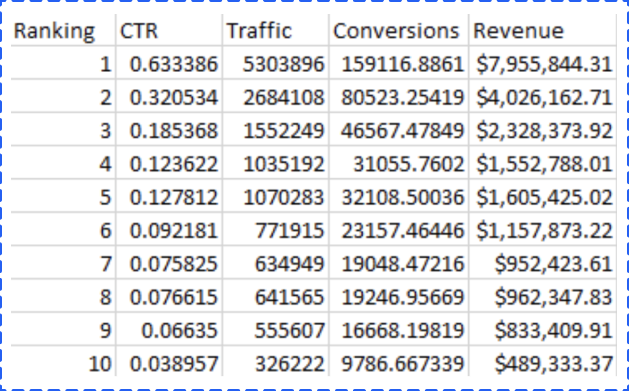
8. Ultimately, this yields a range of potential incremental traffic and revenue. Be sure to couch these numbers against goals and what you think is reasonable for your team to execute.
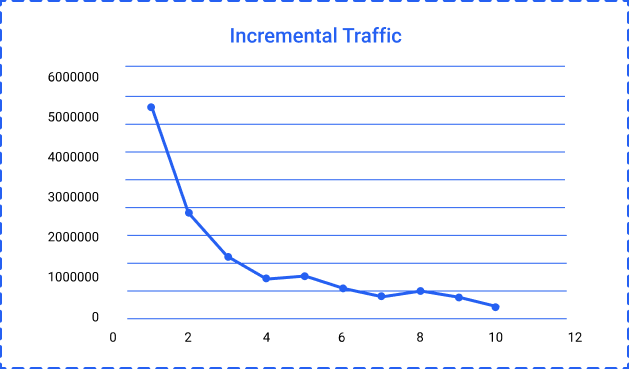

9. Optionally, you can take a more granular approach here and project the improvement in rankings per keyword. In this approach, you would apply a projected ranking to each keyword and then associate the expected CTR from the CTR model above via a VLOOKUP. Using an individual CTR per keyword rather than reviewing a range of opportunity yields more specific projections.
10. To calculate the ROI, you divide the sum of the net returns per keyword by the cost of the work you completed and this will be your annual projected ROI. In the above example, assuming that we achieve position 5 for all keywords, and the agency we hired for the effort cost $250,000 then the ROI is calculated as ($1,605,425.02 – $250,000)/$250,000 or 524.17% in incremental revenue on a $250k investment.
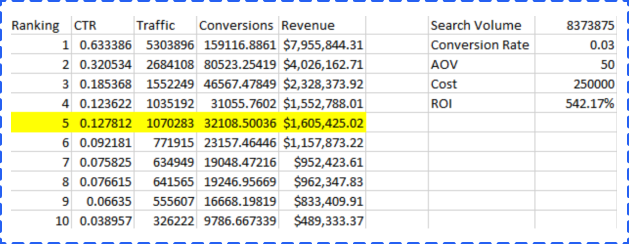
Seasonal SEO projections will greatly resemble your yearly projections but will have the nuance of specific date range. The projection steps will remain the same but the search volumes for the months you’re looking at will need to be checked individually. Last year’s monthly volumes can be used for these projections.
When making projections that are seasonal, it’s important to take into account changes from year to year. If you are in a market that has become more saturated since the previous season, this is something to take into account. Check the SERPs that you’re anticipating the work having an impact on. It’s extremely important to know where you can move the needle and where you cannot. Informational searches will often favor sites like Wikipedia, for example. Similarly, competitors’ branded searches will be virtually unattainable. Other than that, are there companies that entered the industry since last year? Are any competitors no longer there? Adjust expectations and projections in accordance with this knowledge.
If you want to get more specific and have the time to create a truly standout projection, then leveraging some Python and Google Trends might be a great way to do that. Tyler Reardon created a step by step process on how to leverage an API to predict where your traffic driving keywords might be in the next season that is well worth the read. This is an advanced SEO project, however. But if you think you’re up to the task, you essentially need to complete these steps:
1. Export monthly organic traffic for the entirety of last year
2. Export top organic queries by clicks from Google Search Console for the same dates
3. Use PyTrends API to leverage Google trends and pull a seasonality index for these keywords and then map them to each month in the last year
4. Using this seasonality index acquired through Google Trends, you can create a projection model that shows month over month traffic expectations based on seasonality.
5. In a separate column you will project growth of traffic based on SEO projects
6. Finally, you can plot the seasonality model and growth model on the same chart to see by how much you expect to outpace the standard seasonal changes. This is the ROI as the seasonal trend line is the baseline.
Once you’ve gone through the steps of creating SEO projections, you will need to share them with stakeholders. But if you’ve been paying attention, you’ll understand that projections are anything but definitive. The best way to communicate your SEO projections is to ensure stakeholders are educated on how these projections were calculated, and what factors may affect achieving them. You may very well exceed your own projections, but should you fall short, due to factors beyond your control, this education goes a long way to help buffer end-of-year reporting.
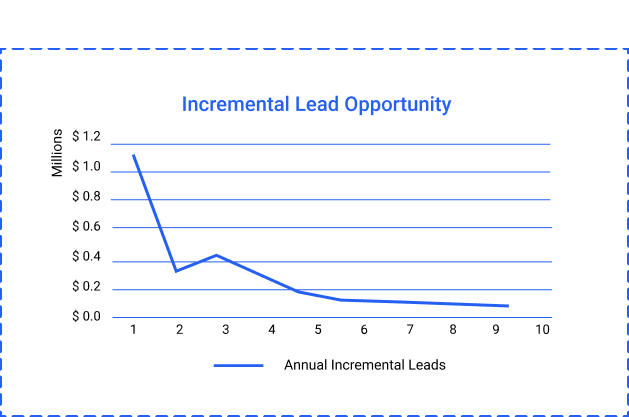
Rather than simply presenting your projections in an attempt to win business or sell a product, use it as information to build a case. Your SEO projections may show that the return on investment is not what stakeholders would like to see in the short term, but can help solidify an expectation of future positive ROI. If nothing else, this may provide an opportunity to identify quick wins, and regroup to discuss a different approach that will provide maximum value.

SEO results are unique to the optimization that was done, the content it was done to, and the website it was done on. Established, authoritative websites may begin to see results in hours, while others may take months.
The time it takes comes down to implementing updates and affecting change in search results.
For impatient stakeholders wanting to see ROI quickly, it’s important to keep them educated on the process, updated on progress, and informed of anything needed to ensure results are seen. ROI is usually calculated and reported on the end of a campaign, or at critical points along the way.
In order to keep stakeholders informed of performance, identify key SEO performance indicators that can be reported on regularly to show positive changes towards improving business objectives.

Whether you are working with a client or on your own product, forecasting is an important first step in SEO work. Not only will it provide an idea of the direction, it can create the necessary accountability for later measurement. While forecasting may not provide 100% accuracy, it can provide a glimpse of what to expect from SEO efforts. And at times, the forecast results can save many future headaches.
A simple glance at the outcomes you anticipate can quickly identify whether you are about to invest an exorbitant amount of time and money into a project that physically cannot yield the results you want.
For example, if your website is built in a way that already limits your SEO effectiveness, like a single-page application design which you have no intention of changing, it’s entirely possible that you will not drive enough additional inbound traffic to justify the effort you put into optimizing your site.
Your forecast can give you clues into what your net return on investment might be. If you anticipate that you will drive 10,000 additional organic users to your site each month, that can be a great starting point.
Assigning value to forecasted SEO performance will indicate how much achieving those goals is worth. Comparing that value to the amount needed to be spent in order to drive the projected results will indicate whether the investment is profitable or not.
Without overpromising on what SEO can deliver, it is a good idea to shoot for a truly great ROI rather than a net positive. However, as forecasting can never be truly precise due to unforeseen variables (e.g. your costs might increase, or the Google SERPs can change causing you to drive lower traffic), you should aim to create a strategy that results in a big enough ROI to ensure you’re not left in the red should those circumstances occur.

Depending on the type of business you have, your projections should reflect the biggest areas of impact. It makes little sense to do full-year projections on seasonal items that sell only during one month of the year.
Conversely, calculating projections for a quarter for products that drive revenue all year is the wrong path to take.
It’s important to remember that SEO is a unique marketing channel that can continuously drive results even after you’ve completed the difficult technical work and are simply maintaining the site. For example, while revenue driven through direct ads will cease as soon as your ad campaign ends, SEO work can continue driving results long after you’ve finished optimizing your site. It’s thus important to give your SEO campaign ample time to prove ROI as revenue will not rise in tune with spending at the start.
Method 1: Annual projections
If you are a year-round business and anticipate that SEO will impact the bottom line throughout the year, then you should calculate your projections based on a full calendar year. The way to do this is look at the areas where you expect to see impact and give a conservative estimate of projected results.

Here are the steps to forecasting annual SEO ROI. We’ll use a sports site as an example to illustrate the process.
1. Compile the data on the historical performance of unbranded keywords for your site in Organic Search by exporting from Google Search Console. For maximum accuracy we recommend pulling data via the Google Search Console API. For illustrative purposes we will be using the 1000 results from the export in the user interface.

The exported data will look like this in Excel:

2. Google Search Console gives an average position value, we want to calculate a CTR curve, so we need to round up to a Rankings value. Do so by creating column F and performing the =ROUND(E2,0) function
and fill down.

3. Create a pivot table of Ranking vs the Average of CTR.

4. Using Rankings 1-10 create your CTR Curve. For extra insight, you can consider pulling live data from AWR’s CTR Study to compare your performance against others in your vertical.

5. Identify the annual search volume of keywords that you do not rank in the top 10 for. You can do this using third party keyword research tools. Also, collect the Organic Search conversion rate, and, if applicable, the average order value. Multiple the CTR by the Conversion Rate to get the amount of potential traffic.

6. Multiply the traffic value by the Organic Search conversion rate to compute the number of potential conversions.

7. Multiply the conversion value by the average order value to determine the potential incremental revenue that this effort will yield.

8. Ultimately, this yields a range of potential incremental traffic and revenue. Be sure to couch these numbers against goals and what you think is reasonable for your team to execute.


9. Optionally, you can take a more granular approach here and project the improvement in rankings per keyword. In this approach, you would apply a projected ranking to each keyword and then associate the expected CTR from the CTR model above via a VLOOKUP. Using an individual CTR per keyword rather than reviewing a range of opportunity yields more specific projections.
10. To calculate the ROI, you divide the sum of the net returns per keyword by the cost of the work you completed and this will be your annual projected ROI. In the above example, assuming that we achieve position 5 for all keywords, and the agency we hired for the effort cost $250,000 then the ROI is calculated as ($1,605,425.02 – $250,000)/$250,000 or 524.17% in incremental revenue on a $250k investment.

Seasonal SEO projections will greatly resemble your yearly projections but will have the nuance of specific date range. The projection steps will remain the same but the search volumes for the months you’re looking at will need to be checked individually. Last year’s monthly volumes can be used for these projections.
When making projections that are seasonal, it’s important to take into account changes from year to year. If you are in a market that has become more saturated since the previous season, this is something to take into account. Check the SERPs that you’re anticipating the work having an impact on. It’s extremely important to know where you can move the needle and where you cannot. Informational searches will often favor sites like Wikipedia, for example. Similarly, competitors’ branded searches will be virtually unattainable. Other than that, are there companies that entered the industry since last year? Are any competitors no longer there? Adjust expectations and projections in accordance with this knowledge.
If you want to get more specific and have the time to create a truly standout projection, then leveraging some Python and Google Trends might be a great way to do that. Tyler Reardon created a step by step process on how to leverage an API to predict where your traffic driving keywords might be in the next season that is well worth the read. This is an advanced SEO project, however. But if you think you’re up to the task, you essentially need to complete these steps:
1. Export monthly organic traffic for the entirety of last year
2. Export top organic queries by clicks from Google Search Console for the same dates
3. Use PyTrends API to leverage Google trends and pull a seasonality index for these keywords and then map them to each month in the last year
4. Using this seasonality index acquired through Google Trends, you can create a projection model that shows month over month traffic expectations based on seasonality.
5. In a separate column you will project growth of traffic based on SEO projects
6. Finally, you can plot the seasonality model and growth model on the same chart to see by how much you expect to outpace the standard seasonal changes. This is the ROI as the seasonal trend line is the baseline.
Once you’ve gone through the steps of creating SEO projections, you will need to share them with stakeholders. But if you’ve been paying attention, you’ll understand that projections are anything but definitive. The best way to communicate your SEO projections is to ensure stakeholders are educated on how these projections were calculated, and what factors may affect achieving them. You may very well exceed your own projections, but should you fall short, due to factors beyond your control, this education goes a long way to help buffer end-of-year reporting.

Rather than simply presenting your projections in an attempt to win business or sell a product, use it as information to build a case. Your SEO projections may show that the return on investment is not what stakeholders would like to see in the short term, but can help solidify an expectation of future positive ROI. If nothing else, this may provide an opportunity to identify quick wins, and regroup to discuss a different approach that will provide maximum value.

SEO results are unique to the optimization that was done, the content it was done to, and the website it was done on. Established, authoritative websites may begin to see results in hours, while others may take months.
The time it takes comes down to implementing updates and affecting change in search results.
For impatient stakeholders wanting to see ROI quickly, it’s important to keep them educated on the process, updated on progress, and informed of anything needed to ensure results are seen. ROI is usually calculated and reported on the end of a campaign, or at critical points along the way.
In order to keep stakeholders informed of performance, identify key SEO performance indicators that can be reported on regularly to show positive changes towards improving business objectives.